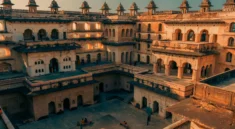
There is a city where the streets are paved with stories, where every step you take seems to echo the soul of centuries past. Lisbon, the capital of Portugal, is not a place to be rushed through in cars or buses. It is a city best explored by foot — one slow step at a time — through its maze of cobbled alleys, pastel-colored buildings, and sun-kissed hills that rise and fall like a gentle heartbeat.
To wander Lisbon is to embrace the unexpected. To walk its hills is to surrender to discovery. Around every corner, there’s something to surprise you: a miradouro (viewpoint) offering a panoramic kiss from the sky, a hidden courtyard café where fado music floats like perfume in the air, or a tile-covered façade that turns a wall into a masterpiece. Let your feet carry you, without agenda, and Lisbon will unfold her secrets with generosity and charm.
A City Built On Seven Hills
Much like Rome, Lisbon was built on seven hills — a fact that becomes undeniably clear as soon as you start walking. At first, the inclines can seem daunting, but it doesn’t take long before the rhythm of the city pulls you in. The hills are not a burden; they are a blessing. They offer constant change in perspective, both literal and emotional. Climbing each hill feels like ascending a new chapter in a book that you can’t put down.
The effort it takes to walk through Lisbon is richly rewarded. As you ascend, you’re granted sudden, breathtaking glimpses of the Tagus River sparkling in the sun. The city’s red rooftops stretch like a painter’s palette, punctuated by ancient church domes and modern rooftop gardens. It’s a living canvas, and you’re part of it.
Alfama: A Tangle Of Soul And Stone
Begin your wanderings in Alfama, Lisbon’s oldest district, a neighborhood that predates even the earthquake of 1755. Here, the streets are narrow and winding, more like footpaths in a medieval village than thoroughfares in a capital city. Laundry flutters on balconies. Elderly locals sit on stoops, chatting in melodic Portuguese. Children chase soccer balls down alleys that feel untouched by time.
As your feet guide you uphill, you may stumble upon the Miradouro de Santa Luzia, one of the city’s most romantic viewpoints, framed by bougainvillea and azulejo-tiled walls. From here, the Alfama rooftops cascade toward the river in a scene that seems straight from a dream. Not far off, the dome of the National Pantheon rises like a pearl, reminding you of Lisbon’s grand and solemn past.
Then follow the sounds — not of traffic, but of fado, Lisbon’s deeply emotional music. In Alfama, small taverns still host live performances where local singers pour out their hearts to the soft strums of Portuguese guitars. Even if you don’t understand the lyrics, the melancholy beauty is universal.
The Elevadores: A Lift To Another Era
When the hills become steep, Lisbon gives you help in the form of its beloved elevadores — funiculars that rattle up the city’s slopes with vintage charm. The Elevador da Glória is perhaps the most famous, connecting downtown’s Praça dos Restauradores to the bohemian Bairro Alto. Riding it is like stepping into a moving time capsule, adorned with graffiti and filled with anticipation.
Another iconic lift is the Santa Justa Elevator, a vertical Gothic-style tower built in the early 1900s by a student of Gustave Eiffel. Ascend it to reach Carmo Convent, a hauntingly beautiful church ruin open to the sky. From its upper platform, Lisbon stretches in all directions, reminding you that this is a city meant to be seen from above — and felt from within.
Bairro Alto To Chiado: Where Day Meets Night
From the gritty and authentic streets of Alfama, your feet might carry you to Bairro Alto, Lisbon’s party district by night and a sleepy village by day. Walking here in the morning feels like exploring a forgotten movie set. The shutters are closed, the streets are quiet, and art is everywhere — painted on walls, hiding in doorways, or staring back from murals.
As the sun climbs higher, make your way downhill toward Chiado, Lisbon’s cultural heart. Here, literary cafés like A Brasileira (haunt of poet Fernando Pessoa) sit next to international boutiques and bookstores. Chiado is where old meets new in a perfect duet — a place where you can sip espresso under gilded ceilings and then browse modern art in the Museu Nacional de Arte Contemporânea.
Unexpected joy often finds you in the in-between: in a small ceramic shop run by generations of artisans, or in a tiny bookstall where you discover a handwritten note tucked into an old poetry collection. Lisbon invites curiosity — and rewards it.
Belém: A Journey Along The Water
Let your wandering take you to Belém, a riverside neighborhood west of the city center. You can walk, or better yet, follow the scenic path along the Tagus River, watching joggers, couples, and seagulls dance under the golden light. Along the way, the 25 de Abril Bridge — Lisbon’s answer to San Francisco’s Golden Gate — stretches across the horizon.
Belém is rich with monuments, each telling tales of Portugal’s Age of Discovery. The Jerónimos Monastery, with its intricate Manueline architecture, is a masterpiece of faith and ambition. The Belém Tower, once a fortress guarding the city’s waters, now stands as a poetic relic of voyages past.
And then, joy takes a sweeter form — in the shape of a pastel de nata, Portugal’s iconic custard tart. At Pastéis de Belém, the original bakery that still guards its secret recipe, you’ll find people from all over the world lined up for this simple delight. Eat it warm, with cinnamon and powdered sugar, and let it melt on your tongue like sunshine.
The Magic Of Miradouros
Lisbon’s many hills give rise to its most beloved treasures: the miradouros, or viewpoints. These open-air terraces are scattered throughout the city like sacred altars to beauty. Each offers a unique perspective, not just of Lisbon’s geography, but of its soul.
Climb to Miradouro da Senhora do Monte, the highest of them all, especially at sunset. From here, you’ll see the city bathed in amber light, the river catching fire, the castle walls glowing, and the trams winding like golden threads through the streets.
Another gem is Miradouro de São Pedro de Alcântara, where you can gaze upon downtown Lisbon framed by blooming gardens. Often, street musicians play here, adding an acoustic soundtrack to your panoramic reverie.
These moments — standing still, breathing deeply, seeing widely — remind you that beauty is often best appreciated on foot and in silence.
Discovering The Undiscovered
While Lisbon’s main sights are magnetic, it’s the hidden corners that truly captivate. A tucked-away courtyard filled with mosaic tiles. A rooftop bar you find by accident. A vintage store behind an unmarked door. A local who invites you in for a glass of ginginha, the city’s famous cherry liqueur.
Sometimes you’ll take a wrong turn and find a staircase leading to a sunlit garden. Or you’ll seek shade under an old tree and overhear a group of locals playing cards, laughing with the comfort of familiarity. These are the unexpected joys — the kind that only reveal themselves when you allow your feet to wander without rush or route.
Walking As A Way Of Belonging
Walking Lisbon’s hills is not just a way to see the city. It’s a way to belong to it, even if only briefly. With each step, you become more attuned to its rhythms — the clink of glasses in a tiny tavern, the scrape of a broom on stone steps, the laughter of children echoing off tiled facades.
You begin to understand that Lisbon is not a destination to be checked off a list. It’s a living, breathing experience. One that you carry in your bones, long after your shoes are worn and your legs are sore. The real souvenirs are not things you buy, but moments you live.
A City That Changes You
When you let your feet wander Lisbon’s hills, you do more than explore a city. You rediscover yourself. The effort it takes to climb each slope becomes a metaphor for life’s uphill moments — difficult, yes, but beautiful and worth it. The unexpected joys remind you to stay open, to let go of plans, to trust the journey.
And somewhere between the scent of grilled sardines, the strum of a guitar, and the view from a sun-drenched terrace, you realize you’ve found something rare: a city that doesn’t just welcome visitors, but gently transforms them.
Lisbon doesn’t rush. It waits for you to notice her. And when you do — when you stop, look around, breathe, and feel — she gives you her greatest gift: a sense of wonder you didn’t know you were missing.
So lace up your walking shoes. Start at the bottom of a hill and follow wherever your feet take you. In Lisbon, the path is never wrong — and the joys you find along the way will stay with you long after you’ve left her golden shores.




